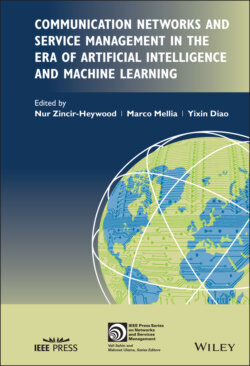Читать книгу Communication Networks and Service Management in the Era of Artificial Intelligence and Machine Learning - Группа авторов - Страница 29
1.4.1 Software‐Defined Networking – SDN
ОглавлениеSoftware‐defined networking (SDN) technology is an approach to network management that separate the control plane from the data plane. In the original internet design indeed, the control plane – where control protocols and management actions are performed – is tightly embedded in the data plane – where packets are routed and forwarded. SDN separates the two planes, so that switches become pure forwarding devices, while all the control and management operations are relegated to a centralized controller. The controller defines forwarding rules, which are then send to switches that use them to forward packets along the proper and desired path. This enables dynamic, programmatically efficient network configuration to improve network performance and monitoring. Martin Casado introduced the idea of relying to a centralized controller to improve network management in 2007 [35]. Since then, SDN technology has become mainstream [36], with support first for campus network, then extending its support for data center networks, and more recently in WANs via the SD‐WAN [37], bringing in the WAN area the benefits of decoupling the networking hardware from its control mechanism.
Figure 1.3 The SDN architecture.
Source: Courteously from Open Networking Foundation.
The SDN architecture identifies three planes – adding an application plane on the top of the control plane. Figure 1.3 depicts the overall architecture. SDN applications are programs that directly and programmatically communicate their requirements and desired behavior via the northbound interface to the SDN network controller. Applications get an abstracted global view of the network, and suggest decisions and actions such as explicit routes, filtering rules, etc. The SDN controller sits in between. It is a logically centralized entity that translates the requirements from applications to actual action to be implemented by the control plane elements, and provides the applications an updated a common view of the network status. Logically centralized, it can be implemented in a distributed fashion to guarantee both scalability and reliability. It supports both the concept of federated controllers – each responsible of managing a portion of the network; and of hierarchical controllers – where higher hierarchy controllers summarize the information received by lower layers and make it available to applications. At the bottom, the data plane – or the Datapath – is the logical network of devices which offer forwarding and data processing capabilities. Data forwarding engines are in charge of quickly switching packets. They communicate with the SDN controller via the southbound interface, which defines standard Application Programming Interfaces (API) to exchange information. Traffic processing functions implement decision based on packet payload. For instance, switching decision can be done considering both the sender and receiver addresses – enabling per‐flow routing. Similarly, filtering decision can be based on TCP port numbers.
SDN is often associated with the OpenFlow protocol [38] that enables the remote communication with the network plane elements and the controller. However, for many companies, it is no longer an exclusive solution, and proprietary techniques are now available like the Open Network Environment and Nicira's network virtualization platform. They all offer the standard API to communicate via the southbound interface.
